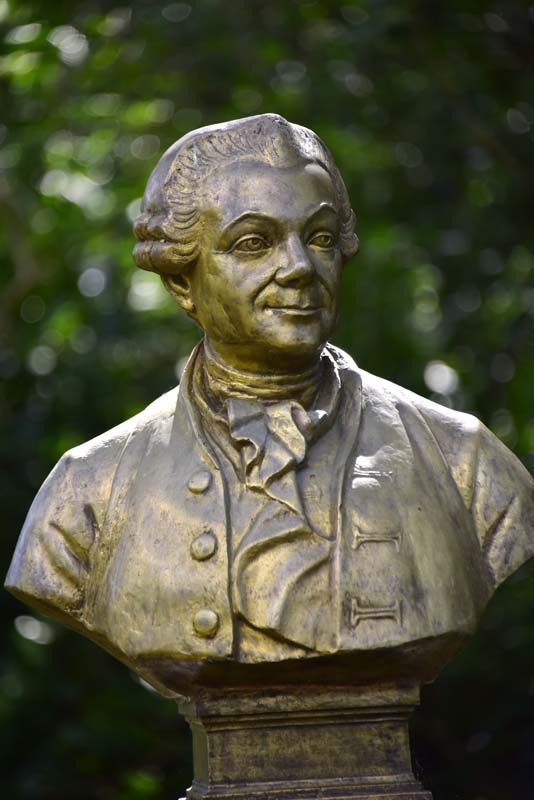



In 1735, Mahé de Labourdonnais was appointed as the French Governor of the island, then known as “Isle de France”. A year later, he purchased the estate of Mon Plaisir and created a vegetable garden with the intention of supplying vegetables to his household, to the town of Port Louis, and to passing ships calling at Isle de France.
The Garden was also a nursery for the planting and acclimatization of plants of botanical and economic importance that were introduced from diverse parts of the world. Among the first major introductions was the Cassava (manioc) which Labourdonnais brought from Brazil to provide food for the population.
From a modest origin as a vegetable garden, Mon Plaisir was transformed into the oldest Botanical garden in the Southern Hemisphere under the leadership of many personalities.
In 1739, the French East India Company took possession of Mon Plaisir and shortly afterwards, almost the entire estate was planted with mulberry trees in the hope of establishing a silkworm industry.
This attempt proved unsuccessful and the mulberry trees were replaced by plantations of bois noir (Albizia lebbeck); whose charcoal was used in the manufacture of gunpowder in the neighbouring gunpowder mill.
From 1746 until 1753, Mon Plaisir was virtually abandoned until the arrival of Jean Baptiste Christophe Fusée-Aublet (1720-1778), a horticulturist, sent to Mauritius to establish a drug house and to create a botanical garden. Fusée-Aublet lived first at Mon Plaisir, but was unhappy there and transferred all his plant collections to Le Réduit, the home of the Governor.
In 1767, Pierre Poivre (1719-1786) was appointed Intendant of the island. Prior to this, he had travelled to Mauritius twice and also to the Moluccas, then under the control of the Dutch East India Company. He had smuggled thousands of spice plants and fruit trees into Mauritius and La Réunion, in the hope of initiating commercial ventures.
To achieve his goal, Poivre occupied Mon Plaisir in his official capacity and in 1770 purchased the estate for himself. He was the creator of the present Garden, since in addition to a nursery for the acclimatization of the precious nutmeg and clove plants, he also collected numerous plants from other regions and as many indigenous plant species as he could.
In 1773, the Garden was sold to the French authorities.
Nicholas Céré (1737-1810) a botanist, born in Pamplemousses, was appointed Director of the Garden in 1775. He occupied this position until his death in 1810. Céré devoted his life and personal fortune to the Garden. He is buried in Pamplemousses cemetery and his tomb proclaimed National Heritage.
As a result of the work of Poivre and Céré, Pamplemousses became well-known to leading naturalists and acquired the worldwide fame it has since retained.
In 1810 the British took over Mauritius. Céré’s son, Jean-Auguste Céré (1764 -1831) took over the management of the Garden from 1810 to 1812. He was second in command until 1823.
In 1849, James Duncan was appointed Director of the Garden. He introduced several plants, including the bougainvillée and many palms, among which was the Royal Palm (Reystonea regia).
Some of the most famous names associated with the Garden include Charles Telfair, honorary supervisor of the Garden from 1826 to 1829. In 1837, Wencelas Bojer, botanist, introduced many species of plants from Madagascar including the ‘flamboyant’ (Delonix regia) and from Africa. He also wrote the first treatise on Mauritian flora entitled Hortus Mauritianus, with a complex nomenclature in 1837.
Other names associated with the management of the Garden are:
- William Augustus Burke (1812 – 1820)
- John White (1820 – 1826)
- John Newman (1826 – 1848
- James Duncan (1849 – 1866)
- Charles Meller (1866 – 1869)
- John Horne (1869 – 1892)
- William Scott (1892 – 1897)
- Joseph Th. Van. Keirsbilck 1897 – 1903)
- Paul Koenig (1903 -1913)
- Charles O’Connor (1913 -1917) (1924 -1944)
- Henry Julien (1944 – 1966)
In 1913, the administration of the Garden was transferred to the newly-created Department of Agriculture. After independence in 1968, it was placed under the aegis of the Ministry of Agriculture, now the Ministry of Agroindustry and Food Security.
